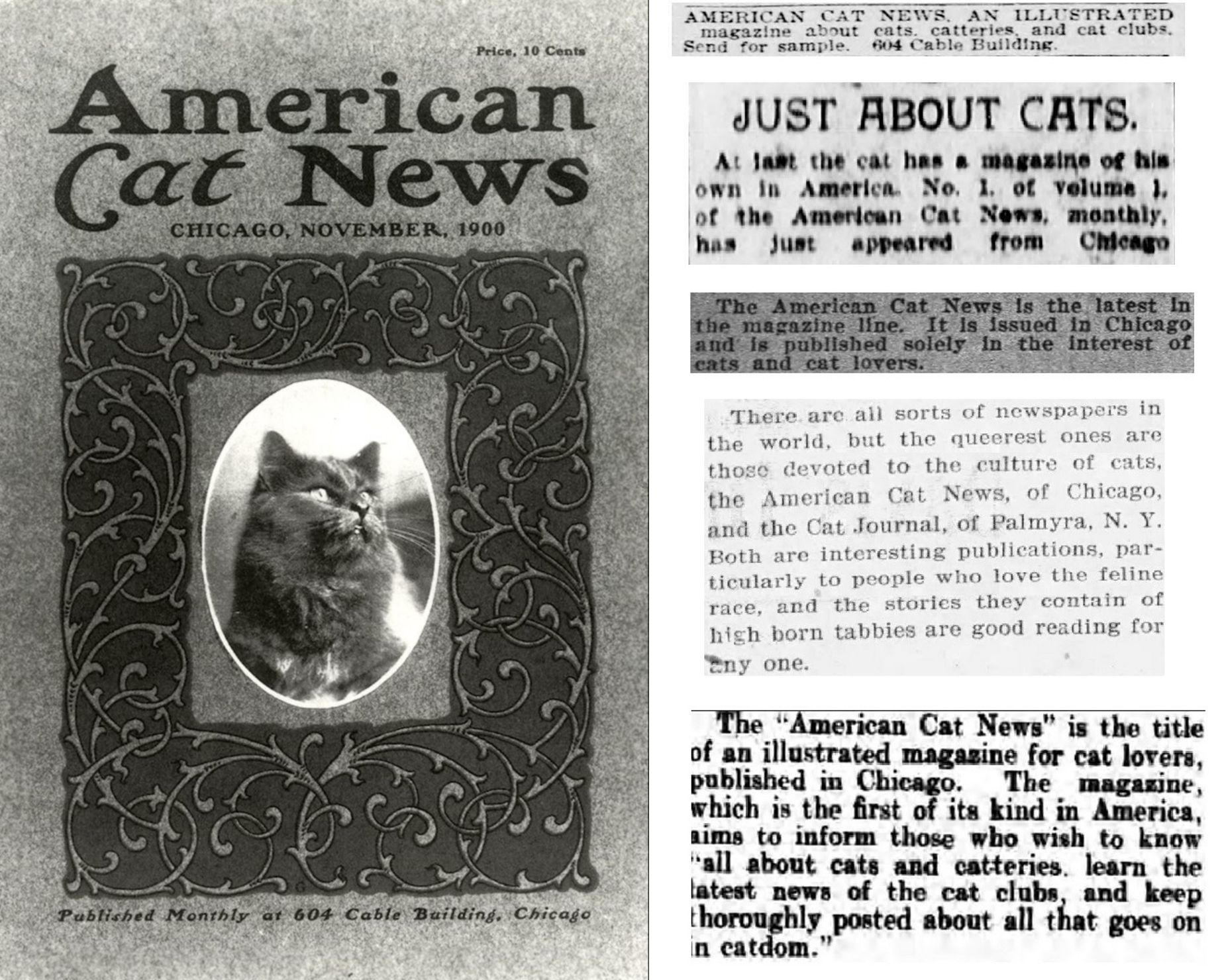
EARLY NORTH AMERICAN CAT MAGAZINES - A HISTORY
AMERICAN CAT NEWS
In North America, a cat magazine called "The American Cat News" was founded in Chicago in December 1900, pre-dating the first national Cat Associations there.
CAT MAGAZINE OUT. The American Cat News is the title of a new magazine, the initial number of which has just appeared. The prospectus of the magazine, signed by C.F. Whitemarsh and F.C. Goudy, the publishers, states that it is issued for cat lovers and its news will be devoted exclusively to cats and catteries. The December number contains half-tone cuts of a number of famous Chicago cats and cats of other cities. The portrait of an unnamed cat adorns the cover, and Teddy Roosevelt, owned by Mrs. L C. Kemp of Huron, S.D., is the subject of the first illustration. There are also cuts of cats of high degree belonging to Mrs. Clinton Locke, Mrs. Leland T. Norton, and other well-known Chicagoans. Most of the news space is devoted to cat gossip. There are personals regarding many furry animals, and a touching obituary of Argent Moonbeam, whose sudden death is said to have "cast a real gloom" over the ninth grand show of the National Cat club. In chronicling the death of White Tsar, the obituary reads: "We feel the greatest sympathy for Mrs. Champion and her daughters. It must have been a keen grief to learn of White Tsar s death. He was bred in their cattery, and these ladles are tenderly attached to all their cats." Among the contributors to the first number are Mrs. Clinton Locke, Mrs. Leland T. Norton, and Blanche Winslow Robinson. The magazine is handsome in appearance. - The Inter Ocean, 16th December, 1900
[AMERICAN CAT NEWS] In this, our day of specialties, when each trade and profession and sport has its separate journal, when even the birds, bees and flowers have theirs, it seems no more than fitting that the cat should be recognized in the periodical world. Since the publication of Miss Helen Winslow's profusely illustrated volume, "Concerning Cats," people are coming to regard more seriously aesthetic feline values. Still, the idea of a magazine to descant on cattish - or should one say catly - charms, and the means of accentuating them might not occur to the general public. It is, however, in response to a crying need of cat lovers that American Cat News has been founded. The magazine is an illustrated monthly, published from 604 Cable Building, Chicago, and aims to have the authoritative word on "Cats and catteries, the latest news of cat clubs and all that goes on in catdom." The first number, well printed and illustrated, is dated December, and the January issue will be ready at once. (Boston Evening Transcript, 9th January 1901)

"AMERICAN CAT NEWS" (Lancashire Evening Post, 5th February 1901) - The 'American Cat News' is the title of an illustrated monthly magazine for cat lovers, published in Chicago. The magazine, which is the first of its kind in America, aims to inform those who wish to know "all about cats and catteries, learn the latest news of the cat clubs, and keep thoroughly posted about all that goes on catdom."
THE CAT JOURNAL, THE CAT REVIEW, WESTERN CAT FANCIER AND OTHERS
A national cat magazine called The Cat Journal was founded in 1901 (also before the first national cat association) and published in Palmyra, New York, by Mr C.H. Jones, a great cat lover who had brown tabbies of "the Maine stock." In addition to The Cat Journal, he started an eight-page paper, "The Weekly Cat News" on October 21, 1911. Due to Mr Jones' illness, The Cat Journal suspended publication after the February 1913 issue. It was not re-started, because Mr Jones died in April 1915. Since 1901, there has always been at least one cat magazine in North America, and sometimes as many as five magazines at once (the size of the country and time to cross it meant the cat fancy and the magazines were quite regionalised). Other early specialist cat fancy magazines were "The Fortnightly Cattarian" and "The Cat Review", both launched in June 1903. In 1903, The Cat Review was owned and published by Mr & Mrs Oliver L. Dosch of Dayton, Ohio; its first issue appearing on 25th June 25, 1903. In 1907, The Cat Review moved to Elizabeth, New Jersey. In the earliest part of the 20th Century, the main voices of the American cat fancy seemed to be "The Cat Journal", "The American Cat News" and "Field & Fancy".
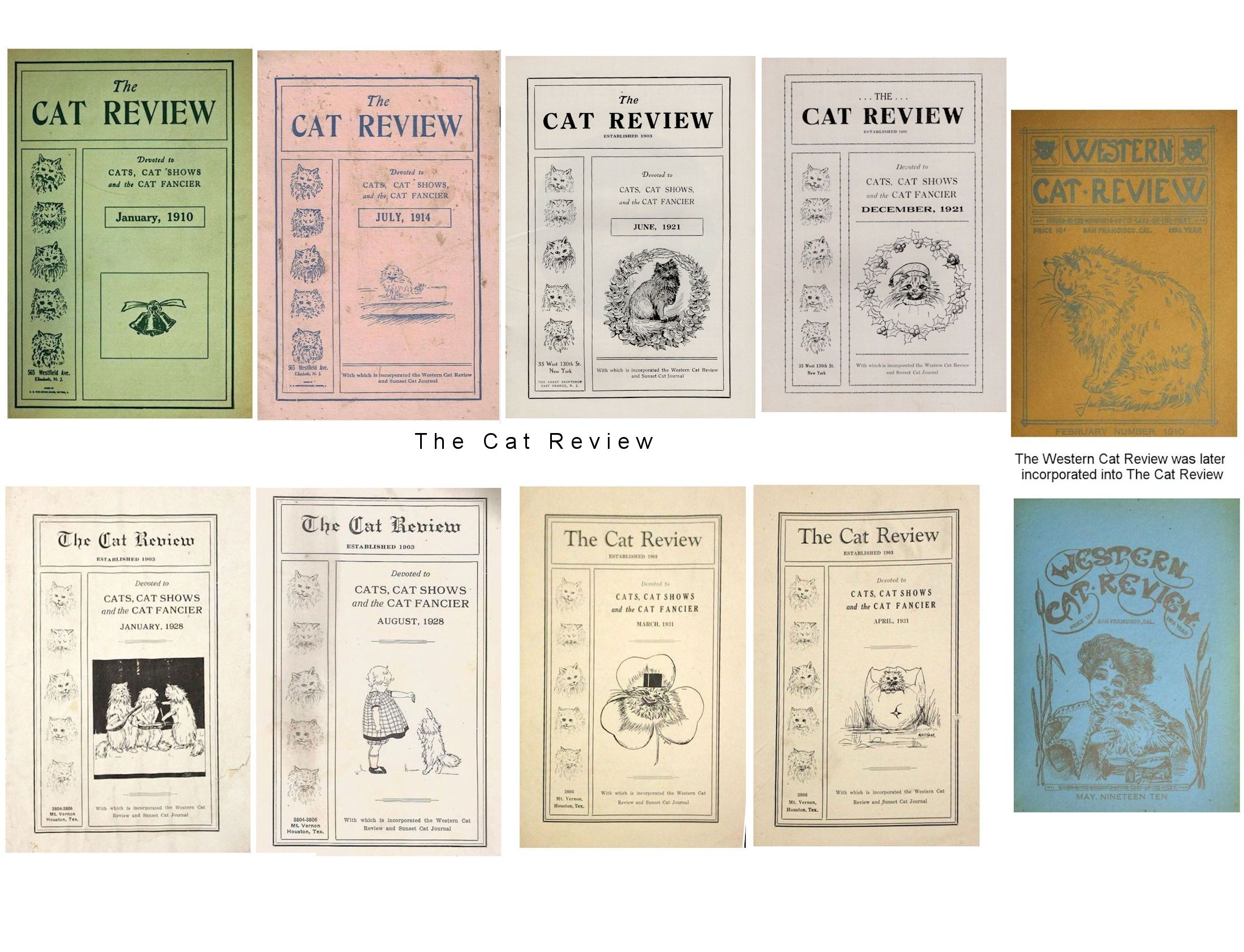
JOURNAL DEVOTED TO CATS OF HIGH DEGREE. "The Western Cat Review," a Journal devoted to the doings of pedigreed cats and, incidentally, their owners, has made its initial appearance under the editorial direction of H. C. Hinds of 1672 Haight street. The paper is intended to encourage cat fancying on the Pacific coast and it thoroughly covers the subject. The success of the cat show held here in February indicated that there was a decided interest in the furry felines, and the Cat Review aims to appeal to all who are cat fanciers. Editorially, the paper says: "The cat fancy has passed the stage of faddism on the Pacific coast, and in donning the garb of commercialism there comes the natural demand for a paper in which the many high bred cats of the west may voice their claims to superiority and attract to themselves that public attention which they so richly deserve. Hence the reason for the Western Cat Review." The Review is unique In one feature as it records punctiliously the social diversions of the cats of high degree. - Various, April, 1909. San Francisco.
On 3rd September, 1906, The Indianapolis News gave this answer to a reader query: You can get books on cats at the book stores. Magazines devoted to the interests of cats are The Cat Review, Dayton, O., and The Cat Journal, Palmyra, N.Y. But almost all periodicals devoted to dogs and pet stock include cats.
In July 1912, Mrs E. Brace contacted Mr C. H. Jones, formerly editor of the Cat Journal, before launching her own magazine. Mr Jones had given up his work as editor/publisher because of a long illness. Since he appeared unlikely to resume that role (and indeed, The Cat Journal ceased publication in ealy 1913), he gave Mrs Brace his blessing for her new magazine.
The monthly "Western Cat Fancier" (a new name for "The Western Cat Review"?) was published in San Francisco. Costing one dollar per year's subscription, it was published by G. Elwyn Willats Willats and edited by Miss Jane Marvin. It carried news and articles for cat lovers. I don't know its dates, but there are references to it in cat show articles during 1915 and 1916.
THE CAT COURIER

"The Cat Courier", began publication in the Great Lakes region in 1912. It was originally edited by Mrs Elizabeth L Brace of Rochester, New York. In 1918, Mrs Brace died and was succeeded as editor by Mrs. Gertrude Taylor (aka Taylor-Ruddy and Taylor-Sweeney) of Detroit, MI. It continued until 1938
PERIODICAL TO GIVE CAT NEWS. First Number Will Be Issued on July 27th. A new periodical is to be launched, the Cat Courier. The first number will come out Saturday, July 27th. The editor. Mrs. Elizabeth Brace, has long studied the care of cats and is well known as an authority. The journal will be published weekly. Among the contributors to the first number is Mrs. Pauline Quirk, wife of a man of letters, Leslie W. Quirk. A department of the Courier will be devoted to the interests of Western fanciers. One corner will be devoted to dogs. There will be news notes every week and correspondence from different persons. Among the advertisers are prominent fanciers. - Democrat and Chronicle, 19th July, 1912
CAT COURIER COMES OUT. New Publication Edited and Published by Rochester Woman. Fanciers are reading with interest thin week the first number of the Cat Courier, a weekly edited and published by Mrs. Elizabeth L. Brace, president of^ the* Lockehaven Cat Club. The little paper starts out with one hundred subscribers, an excellent beginning in view of the short time that has elapsed between the editor's decision to publish the Courier and the date of its first appearance. Valuable information about the American cat and her imported cousins is found in this paper. As Mrs. Brace is president of the Nationsl Short haired Society of America, the everyday puss of obscure birth may look for a share of publicity in this attractive periodical.
C. H. Jones, formerly editor of the Cat Journal, who has given up work for the present because of a long illness, has a courteous contribution in which he writes: "Mrs Brace consulted me before she made the first move, and said that if it was going to have any bad effect on my future plans she would not start her paper. I told her that my plans were so indefinite on account of my health that she need not think of me at all, but, go ahead, and I wished her all the good fortune in the world. She cannot run a paper without advertising support any more than I could. This support must not be for one week, but for all the time and it must be liberal."
One of the evidences of Mrs. Brace s ability as an editor is seen in her arrangement of news. For Instance, there are "notes" about the Washington Cat Club and the Lockehaven Club, a department headed "Correspondence" and another devoted to cat lovers and their pets living beyond the Mississippi. One part, entitled "Barks from Dogland," is devoted to the interests of dogs. A contributor to the paper whose articles will be of interest to readers is Mrs. C. S. McGuire, of Grand Rapids, Mich., who has been a breeder for years. - Democrat and Chronicle, 31st July, 1912
SECOND NUMBER OF CAT COURIER. New Periodical for Fanciers Continues Interesting. The second number of the Cat Courier has been printed, and, like the first, has various points of interest. In addition to the departments of news, this number has news about the doings of fanciers, their journeys, etc. That part of the Courier devoted to news west of the Mississippi is entitled "Fancy of the Occident." There is an article on "Suggestions for Elevating the Stud Book." In the department "Barks from Dog-land" is the information that Miss Christian Loebs, of this city, owner of the Christo Kennels, is a notable young breeder. The English bull Lucky Strip, of those kennels, has recently presented her owner with seven puppies sired by te famous Gotham Magna, his only offspring in America. Mrs Elizabeth L. brace, editor and publisher, urges suggestions as to the improvement of her publication. - Democrat and Chronicle, 5th August, 1912
QUERY COLUMN IN CAT COURIER. Fanciers May Gain Practical Information Through It. With the November number of the Cat Courier the editor, Mrs Elizabeth L. Brace, begins a "Query" column. Any question asked through this department will be answered as soon as the information can be obtained. Persons wishing to know about perfect markings, feeding and different points connected with cat raising will profit by this column. In a short time the Courier will have a series of articles by Joshua Cowpland entitled "recollections." The series will be illustrated with pictures of celebrated cats of the past. - Democrat and Chronicle, 29th November, 1912
CAT COURIER APPEARS. Fanciers who have missed the Cat Courier for some weeks are again getting their copies, owing to the partial recovery from a long illness of the editor, Mrs. Elizabeth L. Brace. Mrs Brace has mailed a number dated November 1st and 8th, in which an editorial explains the cause of many issues not being received. - Democrat and Chronicle, 9th January, 1914
FRIEND OF CATS IS DEAD. Mrs. Elizabeth Brace Was Publisher of Cat Courier. Churchville. Nov. 27. The death of Mrs. Elizabeth Louise Lewis, wife of William Wilder Brace, occurred at her home, "The Willows," just north of this village, at an early hour yesterday morning. She was born in Rome, Oneida county, 61 years ago and was the only daughter of the late Howland S. and Martha Wood Lewis. She resided in Oneida county until 21 years of age, when she moved with her parents to Castile, Wyoming county, where she was united in marriage to William Wilder Brace, who survives her. She has been engaged as owner, publisher and editor of the "Cat Courier," a journal devoted to the interest of the cat. - Democrat and Chronicle, 28th November, 1918
The obituary for Mrs. William W. Brace in the Daily Sentinel, Rome, NY, 13th January, 1919, also mentioned the Cat Courier. "Mrs. Brace was a brilliant literary woman and for the past eight years was owner, publishes and editor of the "Cat Courier," a journal devoted to the interest of cat fanciers, which has been very successful. It enjoys a large and wide circulation, embracing not only every state in the union, but the Dominion of Canada, South America and European countries as well."
Mrs Brace's successor as editor of Cat Courier was Gertrude E. Taylor-Ruddy and her role as editor was often mentioned when she was a judge at shows during the 1920s. The Cat Courier ran for 26 years without interruption until May 1938, when it merged with The Cat Gazette. Shortly after the merger, in December, 1939, The Cat Gazette was merged into All-Pets Magazine, published by Lightner Publishing Company, Chicago, Illinois (this had the knock-on effect that the CFA began printing Stud Books stating from with Volume XXII). Cat Gazette had started out in 1934 in New Jersey, and was the official journal of the Cat Fanciers Association. Publication moved to Dearborn, Michigan in 1934. CFA stud books (Volumes XVI - XXI) were not printed as separate volumes while The Cat Gazette was in publication because the Gazette included a monthly listing of new registrations.
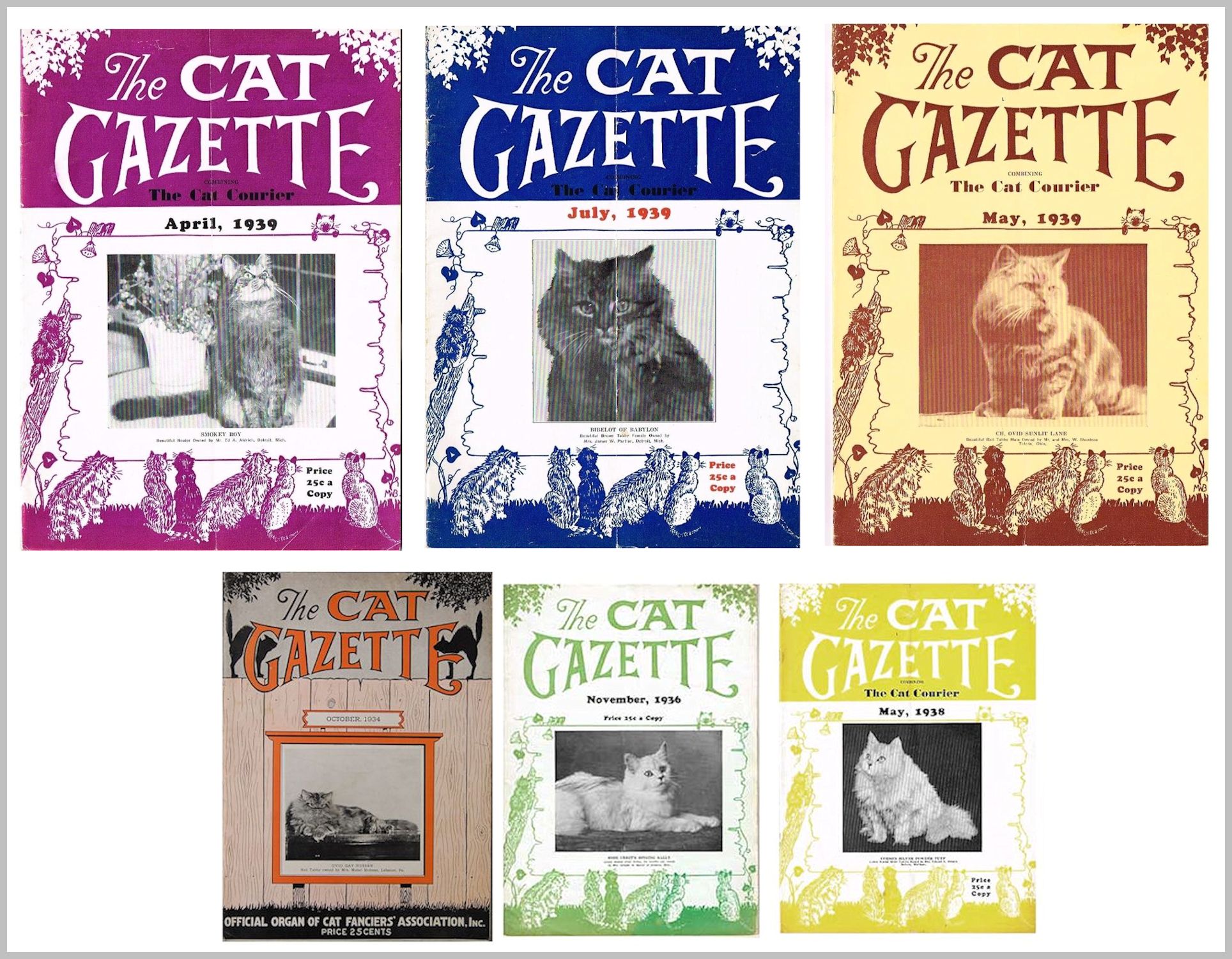
OTHER EARLY MAGAZINES


In 1926, a magazine called "Catdom" was being published in Baltimore, Maryland,but I have no information about its start and end dates. (Source Wilkes-Barre Times Leader, 24th May 1926). Also in 1926, a magazine called "Pacific Cat Journal" was being published in San Francisco, California, again I have no information about its start and end dates. (Source Wilkes-Barre Times Leader, 24th May 1926)
In December 1938, a magazine called "Our Cats" began publication; founded by Alice Graydon Phillips and not to be confused with the British magazines of that name founded in 1899 and again in 1949. "The Cat Digest," founded by Dorothy Grubler of Cincinnati, was first published in 1940, but this was discontinued after only a few years. I can find very little about this magazine and only a little more about Mrs Grubler: "NIFTY KITTY FIRST DONOR TO WAR CHEST (The Cincinnati Enquirer, January 1, 1942) In 1942 Tabby Digest, a Cincinnati cat which is reported to be the most traveled cat in the country, acquired an added distinction yesterday when her contribution to the Red Cross War Fund was entered on the books us the first for the year 1942. The Red Cross books for 1941 had just been closed when Tabby, doing a little more traveling, arrived at the chapter house, 2343 Auburn Avenue, with her donation. Mrs. Dorothy Grubler, 2701 Cleinview Avenue, publisher of the Cat Digest, is Tabby's owner. Tabby has received a medal from the New York port authorities for having traveled 15,000 miles by train, plane, and automobile in the last year and a half."
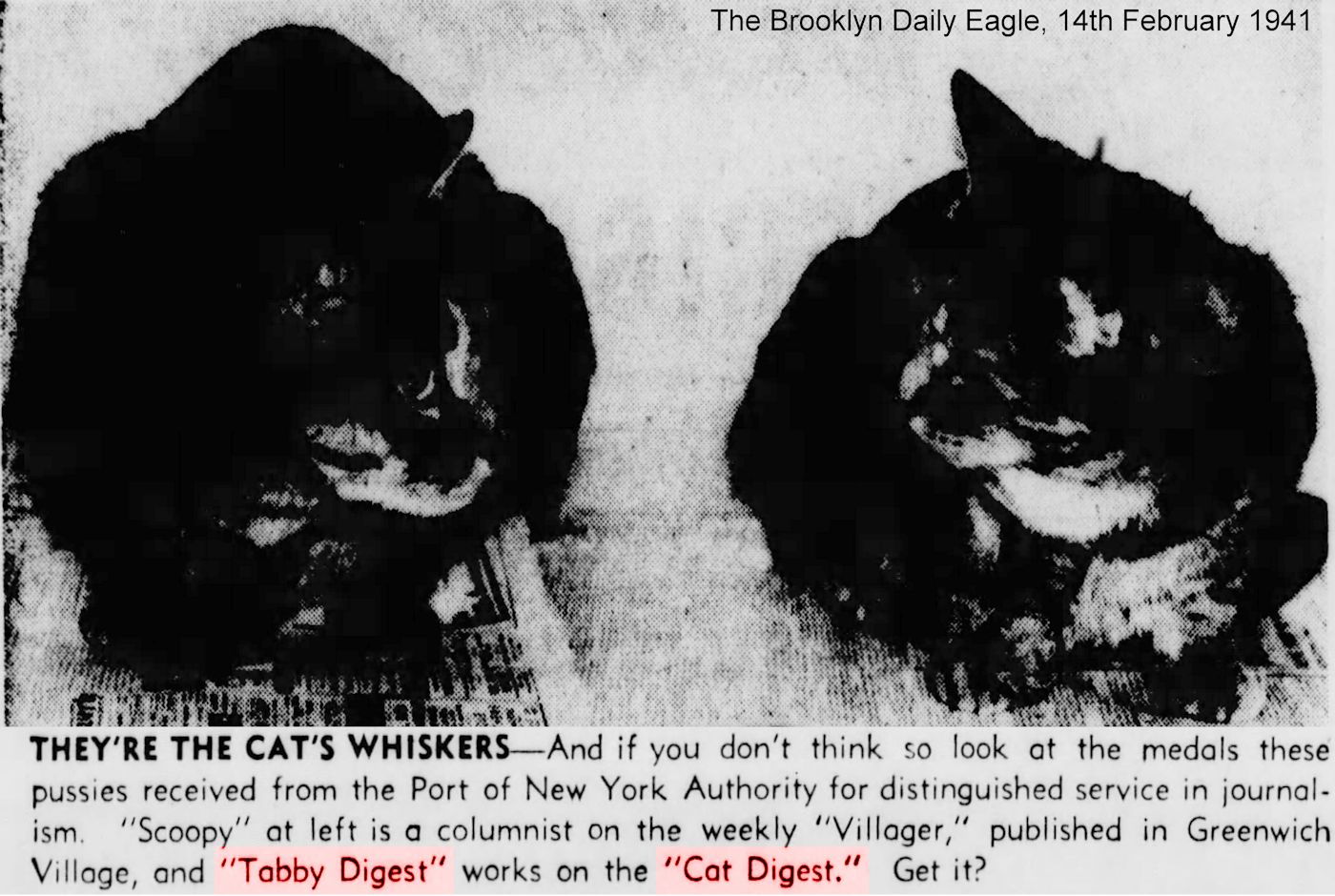
"All-Pets" carried a cat section from 1939 until it ceased publishing in 1966. "Meow," a pocket-size publication, existed for a few issues in the mid 1950s. "International Cat Fancy" was a beautiful and elaborate publication first published in 1965 as a bi-monthly by a company of the same name. Leslie Slawson Smith was the first editor-publisher and president of the company in Studio City, Calif. CAT FANCY cover topics such as spay and neuter, indoors-only, animal rights and responsible ownership. From March/April 1968 issue, CAT FANCY was published by Pet Magazine Inc. in New York and Smith remained its editor. In the September/October 1971 issue, they announced a return to the West Coast and by April 1972 issue, CAT FANCY was published by Slawson Communications Inc. of San Diego.
In January 1945 Cats Magazine first appeared and was the only periodical of its type at that time in North America. Alice Graydon Phillips' Our Cats merged with Cats Magazine in 1949, continuing as Cats Magazine until it suddenly ceased publication in 2001. The British Our Cats magazine was available from the same distributor as Cats Magazine from 1949, and Cats Magazine advertised in Our Cats as being available to British readers.
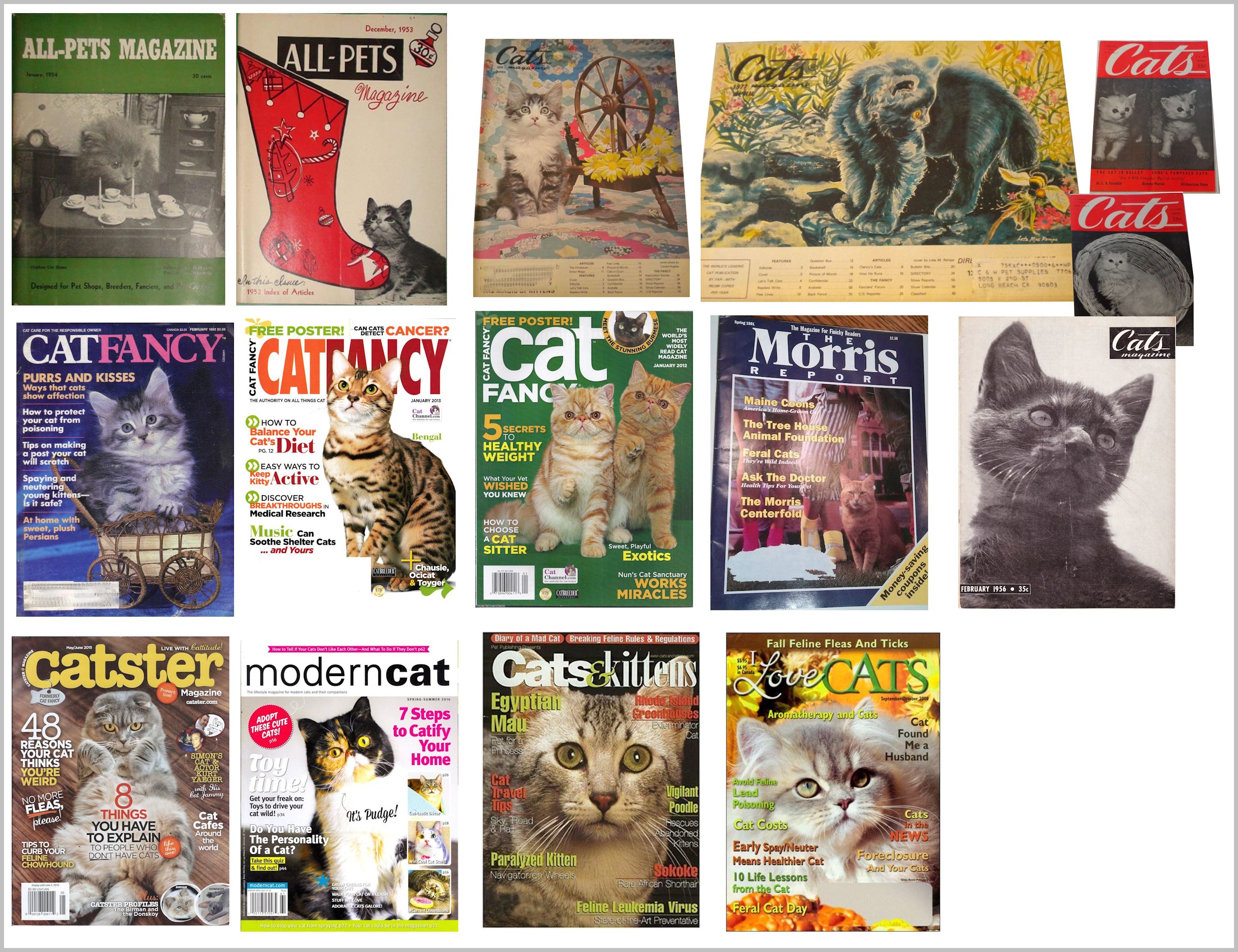
CATS MAGAZINE AND CAT FANCY
Charles A. Kenny founded CATS Magazine in 1945. He and Rita Swenson devised the All-American cats which played a tremendous part in the development of the Fancy and the cat show world. He also created America s National Cat Week which gained favourable publicity for all cats during the 1950's under the direction of its president, Guy Bogart. By 1951 CATS circulation had failed to climb above the 2,000 mark, so Kenny turned CATS over to a former newspaper man who had spent seventeen years with Esso Standard Oil in New York, and whose only connection with CATS magazine was his review of Bell, Book and Candle in the February 1951 issue. Under new management, circulation soared to 30,000 thanks to trust and co-operation between the magazine and the individuals, clubs and associations that made up the cat fancy in North America. CATS supported the CFA and the Cat Fancy in several ways. It was a communication medium inside the Fancy: a Show Calendar, Show Reports, Fanciers Forum and many features telling readers what was going on across the whole country. However, two thirds of its readership comprised individual cat owners, veterinarians and libraries, many of whom learnt about the cat fancy through the magazine's pages, and some of whom went on to become active in the cat fancy.

In February 1984, Raymond D. Smith, editor of Cats Magazine, announced a collaboration with Cat World Internation magazine. Cats Magazine had produced 2 different editions each month: the regular edition and an expanded Exhibitor Edition that included show results. This new publication was a 3-in-1 monthly combining Cats Magazine, Cats Exhibitor Edition and Daphne Negus' Cat World. It increased the subscribers and expanded the audience for advertisers. This is described further down the page.
In 1996, the family-owned CATS Magazine was sold to PriMedia, and its offices relocated "halfway across the USA" with an entirely new and less knowledgeable - staff. A few years later, PriMedia sold CATS Magazine to BowTie, who already owned Cat Fancy. The two magazines now appealed to largely the same audience so CATS Magazine ceased publication with the August 2001 issue and annual subscribers got Cat Fancy for the remainder of their subscription period. CATS magazine s sister publication, Dog World, held on for another decade.
Cat Fancy became a victim of cat culture and could not adapt to a fast-moving, internet-oriented culture of memes, lolcats and amusing video clips, not to mentioned its deformed celebrity felines (Grumpy Cat and Lil Bub). Founded in 1965, its origins were rooted in the more highbrow world of "the cat fancy" with its cat shows, breeder directories and emphasis on pedigree cats. It was informational rather than entertaining. These modern cat-lovers would rather rescue a shelter cat (moggy or pedigree) than buy from a breeder. In 2003, Cat Fancy (owned by BowTie Inc) included more articles about rescues and mixed-breed cats to reflect this change. Cat Fancy never quite made the shift to modern cat enthusiasm which is about fun and lifestyle rather than pedigrees and prizes. It also retained a loyal audience of people (including "serious" cat fanciers) that didn t own a computer, which meant the magazine became a compromise breed and health features alongside shelter/rescue/feral articles and something more light-hearted. But even the cat show listings were moving online where information was updated faster.
BowTie was badly hit by recession and falling revenues. California-based I-5 Publishing LLC, formed in 2013, bought up BowTie s animal-oriented magazines and some of their book contracts, but none of their debts (hence I was never paid for co-authoring "The Original Cat Bible"). As its readership s cat-loving style changed, Cat Fancy s circulation decreased. Its annual circulation was around 160,000 copies. Around the same time as they acquired BowTie's magazines, I-5 noticed the audience appeal of the more light-hearted Catster and Dogster websites, so in 2014 it bought them. A few weeks later, it decided to replace the out-dated Cat Fancy (and Dog Fancy) magazines with two new print magazines named after the websites. Hence, at the end of 2014, after 49 years (making it America s longest-running cat magazine) Cat Fancy was cancelled. I-5 also reduced the frequency of its cat and dog magazines, making them bi-monthly - Catster one month, Dogster the next. This allowed improvements in production quality and increased content. The covers changed from pedigree portraits to cute kitties and the content became "fluffier" to appeal to "kitty parents" and their "fur babies" as well as to cat rescuers. It also embraced the celeb-culture by featuring cat-owning celebrities. Some of Cat Fancy's original audience felt alienated by the new format -fluff rather than serious features - and complained of dumbing down or of chasing the lowest common denominator.
CAT WORLD (For Cat Fanciers the World Over)
This was founded and owned by Robert A. Green of Cedar Grove, New Jersey in 1956 and published 6 issues per year. It was subtitled "The Garden State Cat Club News - For Cat Fanciers the World Over". Its registered address was originally Flushing, New York and until the end of 1959 it was edited by Frank and Analie Comstock who did this job unpaid for the good of the Cat Fancy.
"Cat World" got occasional mentions in the press. The Montclair Times, New Jersey, 12 Sept 1957 mentioned a "column which Dr. Wilson [D.V.M.] writes appears in 'The Cat World,' a magazine dedicated to coverage of this particular animal. His material in the magazine is more or less on a medical angle. Although the Cat World is a New Jersey magazine, Mrs. Wilson said she vas quite surprised to discover that [Dr. Wilson] received letters with postmarks from all over the world."
The Verona Cedar Grove Times, New Jersey, 7th November 1957, helpfully gave some history of the magazine. "Mr. and Mrs. Robert Bird of 208 Claremont Ave., known to cat fanciers as the custodians of "Birdville Cattery . . . joined the Garden State Cat Club, Inc. in 1952 and have been active members ever since. Mrs. Bird writes a column in the Club Magazine 'Cat World,' which is edited by Robert Green of 6 Longview Rd., Cedar Grove. Cat World, which has a subscription of over 200 cat fanciers, is distributed to Belgium, Norway, Switzerland, France, Italy, England, South Africa and New Zealand and recently to Canada as well as throughout the United States. The magazine evolved from an eleven page club bulletin two years ago into the current 24 page magazine with four pages of photographs. There are six issues a year, published bi-monthly. Mrs. Bird is a former editor of the "bulletin." She currently writes a column called, appropriately, 'Cat Meows.'"
Analie Comstock wrote in her final editorial (Nov/Dec 1959) "Although the Job was without a salary, we enjoyed the work tremendously and found our reward in the many friends we have made through the magazine. While during moments of discouragement - and there were a few - we were sustained by the thought that we were contributing in some small measure to the future good of The Cat. It was, with the "future good of The Cat" in mind, that our Seal of Approval was started. We realize that it IS only a "start" and that there is a great deal of work to be done in that direction. What the outcome of our modest attempt will be only time can tell. We hope that the Seal of Approval Program Will be continued, improved, and made an integral part of all the Cat Associations now in existence. It requires a dedicated, strictly neutral, and highly principled group of fanciers to make it work. We know there are such members in the Fancy and upon these the future of the Seal of Approval Program must pin its hopes. Another favorite project of ours was the "Miss Cat World Competition". The first one "1959" held in New Jersey, the second for "1960" just recently chosen in California. We think there should always be a "Miss Cat World" just as there is a "Miss America". . . . we wish to thank all of you who have contributed your time and efforts to the magazine. Without this generous cooperation it would have been impossible to bring CAT WORLD to its present stage of development. To the loyal subscribers we express our thanks and can only wish there had been many, many wore of you."
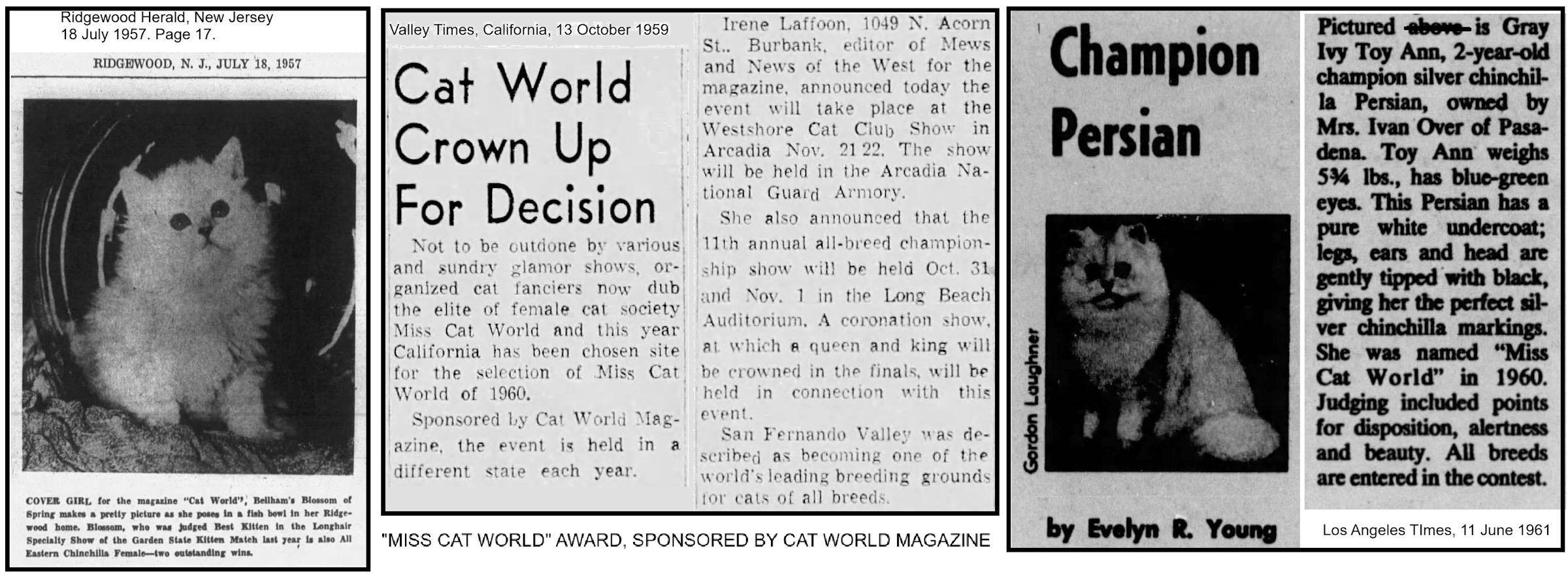
I don't have any further information on how long this magazine continued. I couldn't find any mentions in the media after 1959 (announcing Miss Cat World for 1960) so it appears to ended when the editors stepped down.
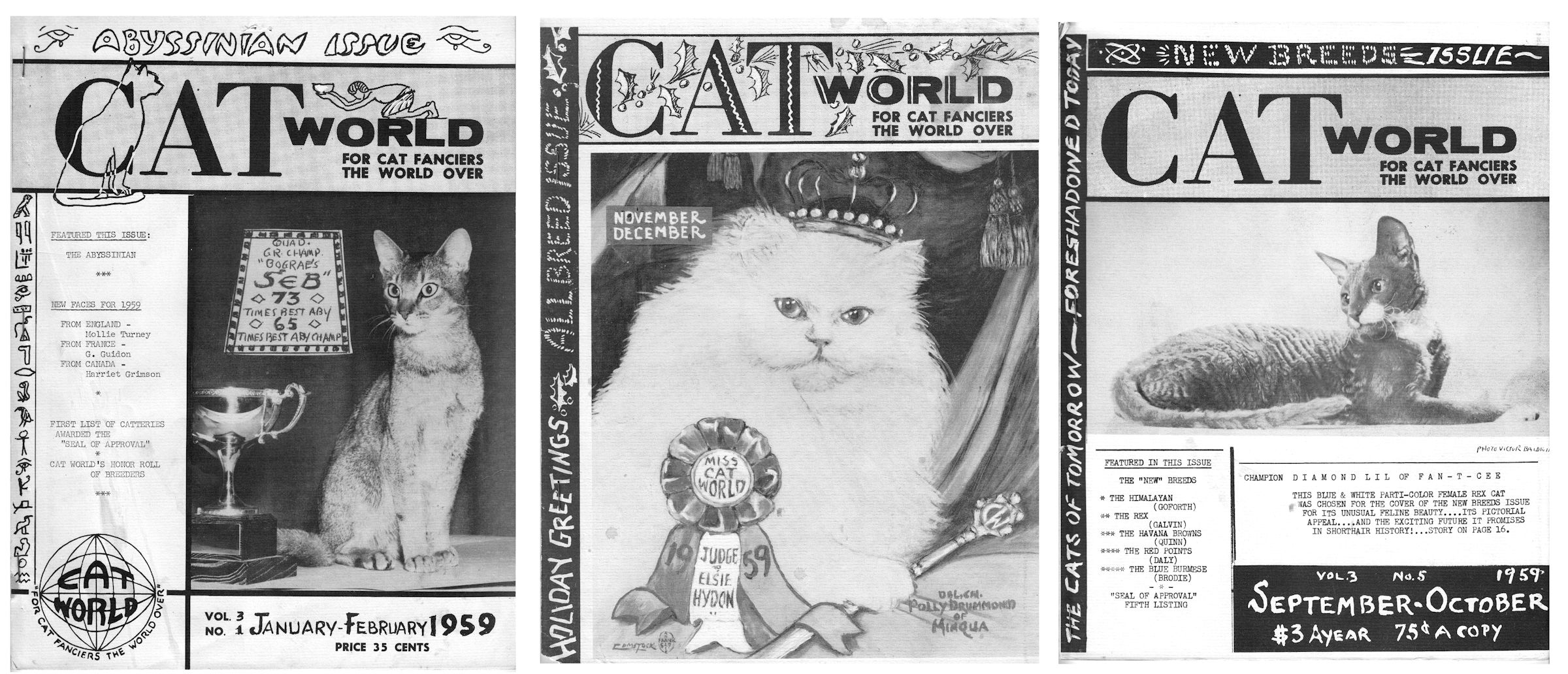
In 1958, Robert A. Green (founder of the magazine) was elected first vice president of the Garden State Cat Club of NJ. In 1959, he was elected its president. He and his wife owned Grand Champion Vel-Vene's Voodoo, a black Persian. In 1960, the Greens were awarded a "Tabby Award"for their service to cats. Coincidentally, Raymond D. Smith, editor of Cats Magazine also received a Tabby Award. The award (it being the first year) were announced by Robert D. Usen, president of the Usen Canning Company, Boston, Massachusetts.
CAT WORLD (INTERNATIONAL) AND OTHERS
Pauline Thompson and her husband originated CAT WORLD Magazine in Denver, CO, back in 1973. Pauline edited it and her husband published it. From March/April 1980, the British couple Richard and Daphne Negus, took it over and moved it to Phoenix, AZ. At the start of 1984, it became Daphne Negus' Cat World (Daphne was already famous for her work with the Korat breed) and began a collaboration with Cats Magazine, another American publication, Cats Magazine was a monthly that offered both an regular edition and an Exhibitor edition (carrying show results in addition to the general content in the regular edition). The combined Cat World and Cats Exhibitor Edition offered a "new and broader concept of complete service to the world-wide cat fancy." The first issue of this joint contribution to cat breeders and exhibitors was included in the February1984 Edition of Cats Magazine. The new publication was a 3-in-1 monthly offering: Cats Magazine, Cats Exhibitor Edition and Daphne Negus' Cat World. This was announced in Cat World International by Cats Magazine editor, Raymond D. Smith. The page size changed to 8.5 inches x 11 inches, but it remained "strictly for the breeder/exhibitor." For Cat World, it approximately doubled the number of subscribers and introduced it to a new audience and meant some subscribers no longer had to buy 2 magazines. For advertisers in both magazines it expanded their audience.
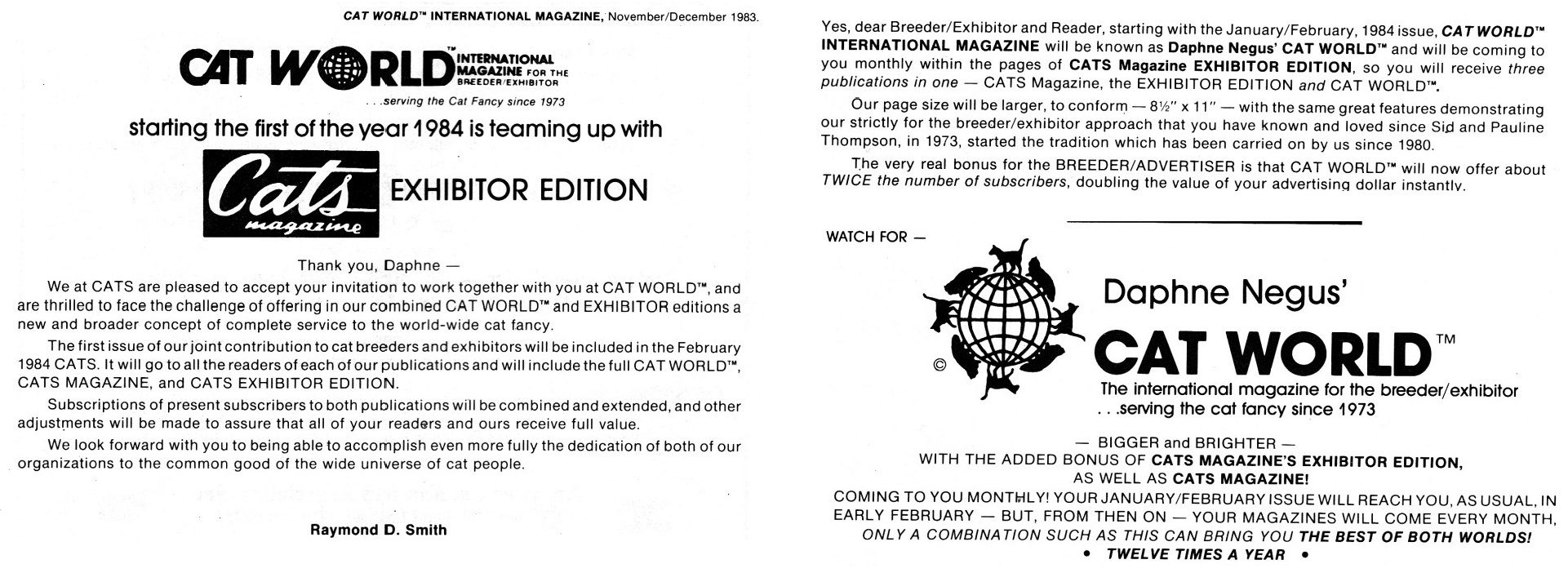
The collaboration lasted a few years until Ray Smith died. The Neguses began publishing it again, but when they moved away from Arizona, they sold the Cat World International title to a local couple who, sadly, could not produce the magazine and so it vanished. The Neguses have since passed away. Many thanks to Pauline Thompson for this information in 2016 while clearing some back issues of CAT WORLD Magazine.
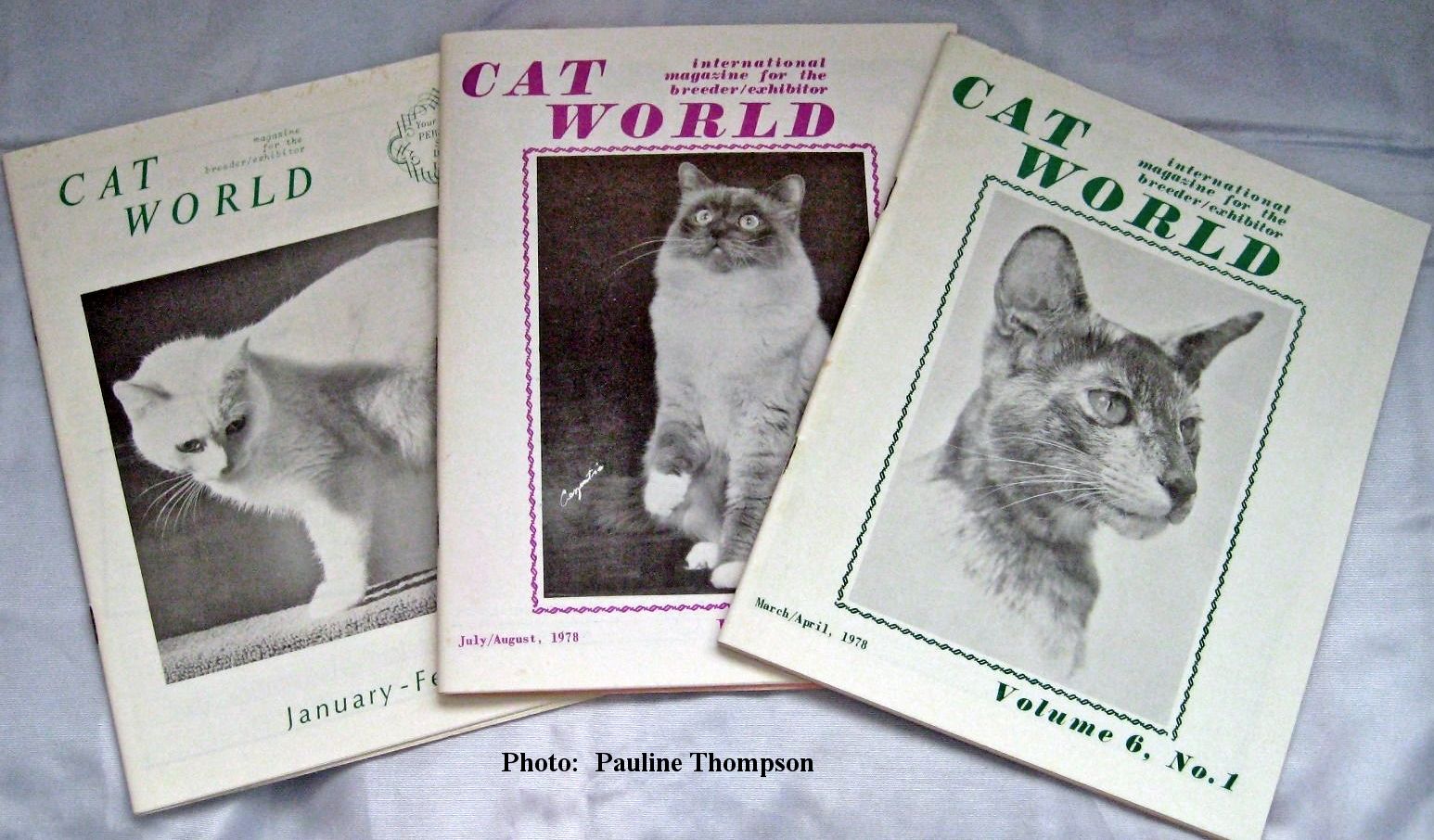
The Canadian Cat Association used to publish a bilingual English/French quarterly called "Cats Canada Chats" but this name is now used by a Feline Canadian Association that defends the rights of Canadian cat breeder (due to different legal systems in the USA and Canada).
Cover images are copyright of their respective publisher and reproduced for the purpose of review and education only.